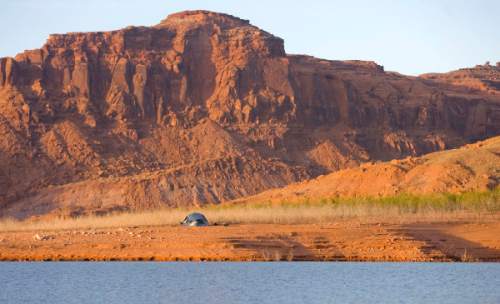This is an archived article that was published on sltrib.com in 2016, and information in the article may be outdated. It is provided only for personal research purposes and may not be reprinted.
Numerous errors and inconsistencies have been discovered within the Lake Powell Pipeline license application, according to the state Division of Water Resources, requiring that "supplementary material" be added to the already voluminous document that will help determine whether and how the billion-dollar pipeline is built.
The 6,000-page application was submitted earlier this week to the Federal Energy Regulatory Commission, which will use it to decide if Utah's Kane and Washington counties will eventually see the 86,249 acre-feet of water that the license application proposes to pump annually from Lake Powell.
In a statement issued Friday, Eric Millis, director of the DWR, said he believes the federal commission has all the information necessary to begin evaluating the environmental impacts and merits of the pipeline proposal, but "we are not satisfied with some aspects of the final reports and we believe clarifications are needed to a number of them.
"We will hold ourselves and our consultant accountable to proactively address any errors or omissions," Millis said.
Joshua Palmer, public information officer for the DWR, said that in addition to numerous typographical and formatting errors and even in-house editing messages, the report contains confusing and inconsistent information.
Much of that, Palmer said, resulted when the main body of the proposal was not modified to reflect information that had been added to the application's numerous auxiliary reports in response to public feedback.
"This is a 6,000-page document, and when you have humans working on projects, humans aren't perfect," Palmer said. "The fact of the matter is there are some things that we need to clarify and make better, and we are dedicated to making that happen."
The DWR released a preliminary draft of its licensing proposal in December to solicit feedback via a 90-day public comment period. Monday was the division's deadline for submitting the finished application for federal review.
Critics of the Lake Powell Pipeline proposal have repeatedly lambasted the state for using data and studies they say are inaccurate and outdated.
The proposal's accuracy was also called into question by more than half of those who submitted comments on the preliminary licensing documents — though 102 of those accuracy complaints arrived by way of a form letter.
The license application describes three different routes the Lake Powell Pipeline could take, and offers two alternative courses of action that would not involve building the pipeline.
The primary proposed action parallels Highway 89 from Lake Powell, but diverges south to go around the Kaibab-Paiute Indian Reservation.
Alternative routes would have the pipeline cross various portions of the reservation. Palmer said the state prefers the route that circumnavigates the reservation because of cost considerations, and because it would be easier to construct and would have fewer impacts on environmental and cultural resources.
The application estimates that the pipeline, were it to be built today, would cost between $1.3 and $2.8 billion, depending on the route and features included in the final project design.
As alternatives to the pipeline, the application proposes developing other water resources, or taking no action, which the state believes would cause Washington County to exhaust its planned water reserves by 2028.
But it could be some time before the state is ready to break ground on the project; the Federal Energy Regulatory Commission is expected to take at least two years to review the license application.
Twitter: @EmaPen



